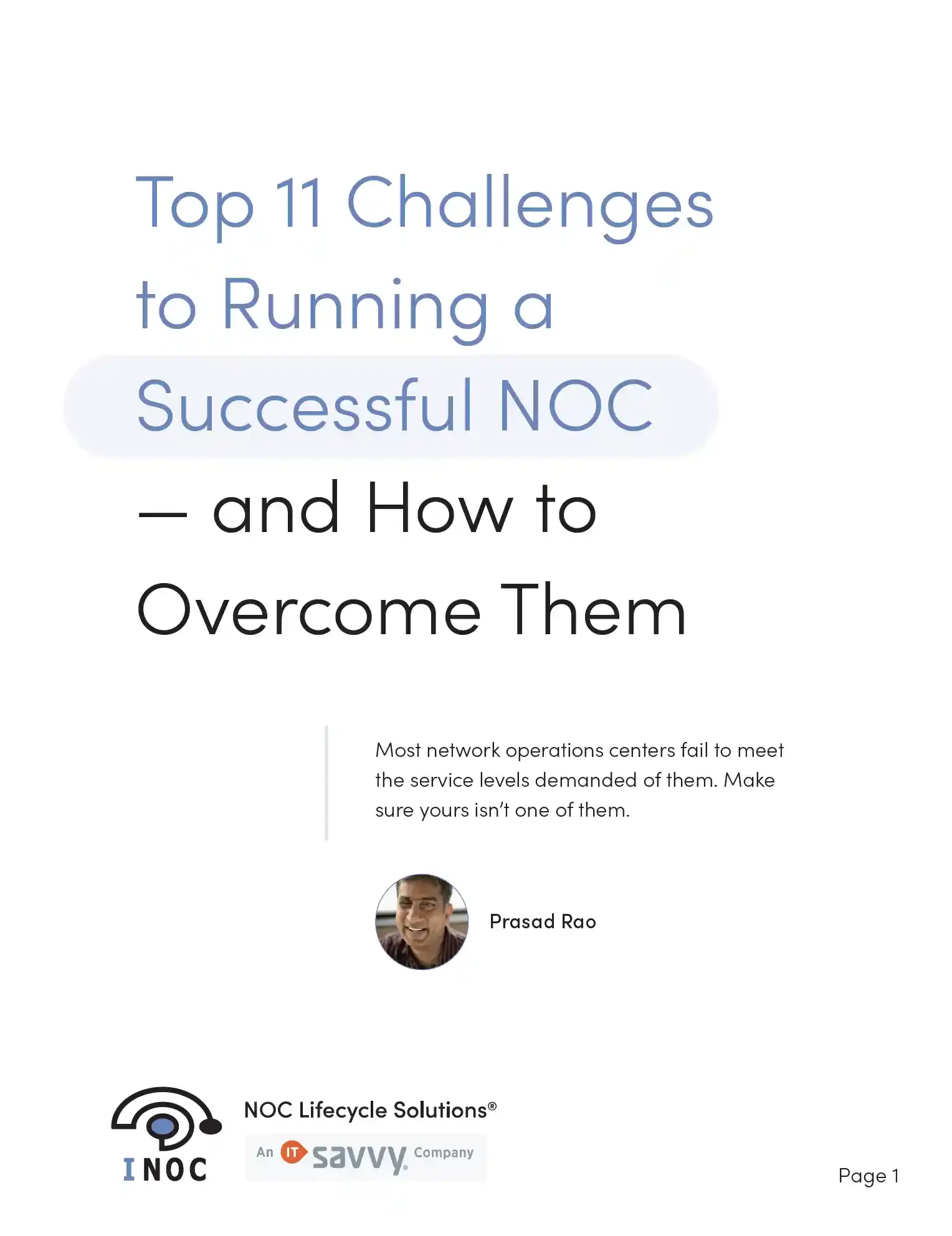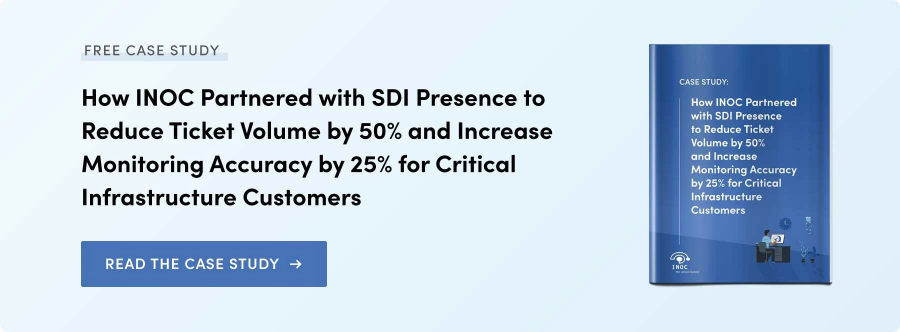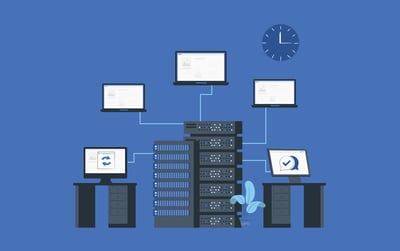In case your time is short
- Multi-site businesses often struggle with network management due to stretched internal IT resources, making them prone to constant "fire-fighting" and leading to costly downtime. Outsourcing to a high-quality, 24x7 NOC can significantly enhance network performance and reliability by taking over extensive monitoring, maintenance, and immediate response tasks, freeing up internal teams to focus on strategic initiatives.
- INOC leverages its strategic acquisition from ITsavvy to offer a centralized NOC platform and service that unifies monitoring and management for multi-site operations. This integration includes advanced tooling, proactive security measures, and hardware lifecycle management, which streamline operations and improve responsiveness across all network sites, ultimately enhancing efficiency and reducing logistical challenges.
- Specialized NOC support offers a blend of immediate operational relief and long-term strategic partnership that adapts to the evolving landscape of IT needs. It addresses the challenges of managing diverse technologies, ensures scalability, and integrates emerging technologies like SD-WAN. Additionally, it offers robust tools for proactive network management, reducing downtime and mitigating potential disruptions before they affect operations.
Businesses operating across multiple locations face unique (and uniquely tough) network operations challenges that, as we’ve seen time and again, can overwhelm internal IT operations teams.
When in-house teams are stretched thin by a high volume of break-fix activities or are challenged beyond their expertise, companies find themselves in constant fire-fighting mode—lurching from incident to incident and pulled away from revenue-generating projects—all while outages and downtime rack up costs and diminish reputations.
This guide lays out the specific network operations challenges these organizations commonly face and makes a clear case for high-quality, 24x7 NOC support as a solution to almost all of them.
If this discussion resonates with you or helps you articulate the need for better NOC support, don’t hesitate to contact us and schedule a discovery call. We’d love to talk NOC and show you how we’ve solved these challenges for companies like yours.
INOC + ITsavvy for multi-site support
At INOC, we regularly augment internal ITOps teams by taking on substantial portions of the break-fix workload, especially in day-to-day monitoring, maintenance, and immediate response tasks. We also deliver the tooling and operational expertise to make networks more observable and better performing across the board.
Leveraging our strategic acquisition by ITsavvy, one of the nation’s leading integrated IT products and technology solution providers, we offer access a centralized NOC platform that consolidates monitoring and management for multi-site network operations, significantly enhancing efficiency and responsiveness.
Our combined services include integrated hardware lifecycle management and local smart-hands service across the country, ensuring all hardware is current and performs optimally while reducing logistical issues associated with maintenance and upgrades. It’s an elegant hardware and service combination you’ll unlikely find elsewhere.
Proactively, we focus on security by continuously monitoring vulnerabilities, conducting risk analyses, and promptly deploying updates and patches. Our onboarding process is streamlined and standardized using detailed runbooks and automation, guaranteeing smooth integration of new sites and technologies.
The Growing Complexity of Multi-Site IT Operations
Technical teams working in multi-site environments don’t have it easy. Their infrastructures must be robust enough to support diverse and geographically dispersed locations while maintaining efficiency, security, and reliability everywhere—sometimes 24x7.
Having worked with many multi-site organizations in areas like retail, manufacturing, finance, hospitality, and healthcare, we’ve observed a few common characteristics of these operations that underscore the challenge here:
-
Multi-site companies often centralize their data management to maintain consistency in handling and accessing data across all locations. This centralization typically involves using cloud services or data centers that serve all sites, enabling better data integration and retrieval.
-
Ensuring reliable and secure connectivity between sites is extra critical. We often see investments in high-quality VPN services, dedicated lines, or sophisticated networking solutions that provide fast and consistent communication. Network reliability is crucial for accessing real-time data and supporting multiple decentralized operations with centralized oversight.
-
While the overarching IT strategy might be centralized, on-the-ground IT support must often be localized to address immediate technical issues and accommodate local needs. In other words, multi-site organizations must be locally responsive while maintaining centralized quality control and policy enforcement—a considerable management challenge that gets harder and more complex as the number of sites grows.
-
IT systems must be scalable to accommodate growth and flexible enough to adapt to changing business needs or local market conditions. This often requires modular IT architecture and cloud-based solutions that can be scaled up or down as necessary. Again, it’s not an easy management task—and one that’s hard to find the expertise to address.
-
In some industries, like manufacturing or retail, multi-site companies might incorporate IoT devices and edge computing into their IT strategy to enhance real-time data collection and processing locally while still syncing crucial operational data to the central system. This only adds to the complexity of managing the network and demands specific technical and operational expertise.
This is all to say that IT operations in a multi-site company require a blend of strategic centralization, effective local execution, and incredibly diligent management. And over the past few years, changes in tech and business practices have pushed the workload to an unsustainable level to handle internally while still finding time for strategic projects.
For example:
- The move to cloud services has generally made networks more scalable and flexible. But managing hybrid environments—where some resources are kept on-premise while others are moved to the cloud—makes network operations much more challenging. IT teams must now be proficient at managing multiple cloud platforms and integrations, which can stretch their capabilities and resource bandwidth.
- The shift towards more remote and hybrid work models following the pandemic has required IT teams to manage more complex network architectures and ensure secure, stable remote access. This shift has also increased the demand for IT support services and intensified the need for robust cybersecurity measures.
- Businesses increasingly expect their IT departments to be agile and innovative, adapting quickly to changes in the market or technology. This pressure can be challenging to address, particularly when resources are already stretched.
- As businesses become more reliant on technology for day-to-day operations, downtime or IT issues can severely affect productivity and revenue. Simply put, with businesses reliant on uptime, downtime is simply unacceptable from a business standpoint. This increases the pressure on IT teams to ensure systems are robust, redundant, and quickly recoverable.
The Critical Role of the Modern NOC in Supporting Multi-Site Organizations
The aggregate impact of all this complexity and pressure makes it easy to see why multi-site companies often need a network operations center to monitor and manage it. A great NOC is more than just a monitoring hub; it provides robust, responsive, and integrated network management essential for addressing technical and operational challenges head-on.
-
Unlike an ad hoc support team—”some people in a room with some tools”—a NOC offers real-time, centralized control over multiple locations. It puts eyes on every device and every problem that arises amongst them and acts on them to respond more quickly to events and incidents.
-
NOC teams typically have more specialized break-fix skills, allowing in-house IT to focus on the revenue-generating tasks they were hired to do.
-
A NOC that operates 24x7 significantly cuts down on middle-of-the-night calls to that in-house team.
The list goes on, but here’s the dilemma: despite needing a formal NOC, only a tiny fraction of multi-site companies are in a position to actually build and run one internally. It’s simply too expensive, too difficult, and too much work to bring a NOC to life, let alone attract and retain the staff capable of hitting service levels.
Let's unpack this a bit.
Why an in-house NOC doesn’t make business or practical sense—most of the time
-
It’s simply not a feasible business investment. Multi-site companies aren’t typically in the IT space themselves, so they’re not well-positioned from a business perspective to build a NOC (unlike, say, a telecom company). Staffing a NOC to operate continuously—three shifts a day, 365 days a year—is difficult to plan and manage, not to mention prohibitively expensive for most companies who need this support. The absolute minimum personnel requirement of a 24x7 NOC is 10 to 12 people. Between planning a NOC build, hiring and training that team, and aligning over the operational plan, in-house NOCs can expect 16 to 24 weeks minimum before all the parts are even in place. It can then take months or years to gain confident control over the system and bring it into a state of real operational maturity.
-
Most in-house NOCs lack a centralized monitoring platform. Like the sites they support, they struggle with disparate systems across various locations, leading to inefficiencies in monitoring and managing network health and performance. Without such a system, in-house teams often have to manage multiple portals or dashboards, complicating the oversight and rapid response necessary in a multi-site environment. This problem tends to scale with growth.
-
Speaking of scalability, this is another area where in-house NOCs often fall short. The infrastructure and processes suitable for a few sites don’t typically efficiently scale with business growth. Hardware availability, highlighted during supply shortages in the pandemic, is particularly problematic, with in-house teams struggling to source and manage necessary equipment swiftly.
-
In-house NOCs often lack comprehensive configuration management databases (CMDBs), which are crucial for effectively managing large networks across multiple sites. A robust CMDB provides a detailed overview of the network's configuration, assets, and their relationships, as well as third-party contact information—all of which is essential for diagnosing and resolving issues efficiently. Without such a system, identifying the root cause of outages, especially those impacting multiple sites, can be slow and error-prone. Figuring out who to call only adds to the delay. In-house teams might struggle with the sheer volume of alerts and data, making it difficult to pinpoint common causes or patterns. For example, if multiple locations simultaneously experience network issues, a well-maintained CMDB can help determine if these sites share a common service provider or infrastructure component—and who specifically they need to get in touch with. This capability allows NOC operators to quickly ascertain whether an issue is localized or part of a larger, systemic problem, such as a service provider outage.
-
Onboarding new sites or technologies within an in-house NOC can be a cumbersome and inconsistent process. In-house teams often lack standardized procedures, leading to variations in how new hardware and software are deployed and managed across sites. This means prolonged setup times, increased risk of errors, and a greater burden on internal resources. Also, in-house teams may not have the same level of access to vendor support or the latest technology training, which can complicate new integrations.
-
The diversity of technology across sites, especially in companies that grow through acquisitions, can also overwhelm in-house NOCs. Each new site may introduce different technologies and equipment, creating a hodgepodge that needs to be managed cohesively. In-house teams often lack the specific expertise across all these technologies, making integrating and managing new sites difficult.
- Lastly, we see many in-house NOCs lack the sophisticated tools required for proactive network management. In-house NOCs seldom have the budget or ability to incorporate cutting-edge AIOps tooling to identify and rectify problems before they escalate, such as through self-healing networks and automated alerts that can preemptively address issues.
How Third-Party NOC Service Providers Offer an Ideal Solution
The control and assurance once afforded by keeping the NOC in-house have largely been upstaged by third-party service providers that have bridged those gaps and developed incredible platform capabilities that simply wouldn’t be viable in-house investments.
The right NOC partner can offer the blend of specialized skills, cost-efficiency, and continuous operational support that significantly enhances the capabilities of in-house IT teams while keeping networks up and running at all times. For multi-site companies facing the complexities of modern IT infrastructure, plugging into the right service delivery platform and tiered support team can offer immediate relief from operational pressures and a strategic partnership that can adapt to the evolving landscape of IT needs.
Here at INOC, for example, our highly structured NOC that puts a powerful Tier 1 team on the frontline typically reduces high-tier support activities by 60% or more, often as much as 90%.
📄 Related » Outsourced NOC vs. In-House NOC: 3 Factors to Consider
Below are several nuanced challenges that companies frequently encounter as they manage a growing number of sites—and how the right NOC service provider is well-positioned to solve them.
1. Managing diverse and disparate technology ecosystems
As networks expand, they often evolve into diverse ecosystems comprising various types of equipment and technologies. In a multi-site organization, this diversity can create a patchwork of technologies that must be managed cohesively. Integrating new stores or sites, each possibly bringing different systems into the corporate network, adds another layer of complexity.
One of the biggest benefits our multi-site clients get through NOC service is the ability to centralize data from multiple sites into a single monitoring and management platform. This centralized approach eliminates the inefficiencies of managing disparate systems across various locations. Unifying network operations into one accessible platform directly enhances operational efficiency and responsiveness to issues that arise anywhere in the system.
Network managers get immediate access to real-time data and system statuses, improving decision-making and reducing response times for resolving site issues. In short, the right NOC provider, one with broad expertise across technologies, can navigate this diversity more effectively than in-house teams that may not have the bandwidth or knowledge to manage such varied environments.
INOC Ops 3.0
Our Ops 3.0 platform — the heart of our NOC support service — is engineered to simplify complex network operations through a seamless integration with all major NMS platforms and ITSM tools, giving companies a unified, multi-tenant architecture that enables swift, accurate, and efficient management of various technological environments.
We can ingest alarm and event information from your NMS infrastructure (such as LogicMonitor, New Relic, Nagios, or Dynatrace), enabling us to receive alarms from a simple network monitoring tool or a whole suite of monitoring tools (everything from application management to traditional network management to optical or physical layer management systems). If you don’t currently use an NMS or aren’t satisfied with your instance, hosted solutions like LogicMonitor, New Relic, or iMonitor (our headless alarm management platform) are available.
Here are a few reasons multi-site companies choose to inherit our platform capabilities rather than spending hundreds of thousands of dollars and many years building their own:
-
Advanced automations — Ops 3.0 employs AIOps to automate alarm feed ingestion and correlation, drastically reducing detection time to resolution. This automation extends to incident ticket generation, enriched with data for quick and accurate troubleshooting.
-
Seamless Integration — The platform supports seamless integration with various NMS and ITSM tools. This integration capability ensures that regardless of the underlying technologies used across different sites, they can all be managed effectively through a unified platform.
-
Customizable multi-tenant architecture — Ops 3.0 offers a secure, discrete multi-tenant architecture tailored to your sites’ specific security and operational needs. While resources are used efficiently, data isolation and client-specific configurations are maintained without compromise.
-
Enhanced incident management — With its robust Configuration Management Database (CMDB) and automated workflows, Ops 3.0 expedites incident response. This streamlined process enhances incident management, optimizes resource allocation, and reduces human error by prioritizing incidents based on their business impact.
2. Underestimating the impact of downtime
Another area often overlooked until it becomes a problem is the true cost of downtime. For multi-site operations, especially in sectors like retail or hospitality, the impact of network downtime has escalated significantly due to the reliance on continuous online operations for ordering systems, customer interactions, and integrated services (think DoorDash or UberEATS as prime examples of companies that live and die by availability).
NOC services that offer rapid response and proactive monitoring can dramatically reduce these downtime costs, providing a safety net that many companies fail to appreciate until after they experience a costly outage.
Again, for issues that can “resolve themselves” quickly, such as minor fluctuations or temporary disruptions, Ops 3.0 includes automation that can recognize and close these incidents without human intervention. This not only speeds up the resolution process but also keeps the NOC team focused on more critical issues.
Ops 3.0 integrates seamlessly with external communication platforms, ensuring that all stakeholders are promptly notified about potential issues. This capability is essential for coordinating rapid responses across different locations and services.
3. Hardware lifecycle management
One of the subtler challenges in scaling network operations is managing hardware scalability across numerous sites. As companies grow, the demand for uniform hardware deployment becomes critical, yet this is often where operations stumble. The procurement of hardware, particularly during global supply chain disruptions as witnessed during the pandemic, can delay deployment schedules and disrupt service continuity.
By streamlining the process of upgrading and managing hardware, ITsavvy and INOC ensure that technology across all sites remains current and performs optimally. This proactive approach extends the lifespan of hardware and enhances overall network reliability and performance, reducing the risks and costs associated with outdated or malfunctioning equipment.
4. Complex vendor management
Multi-site operations often involve juggling multiple vendors and service providers, each with its own systems, response times, and service quality standards. Bridging the gap between these providers and ensuring consistent service levels across all sites is a complex task that internal teams often underestimate.
A dedicated NOC service can centralize this process, offering a single point of contact and coordination that simplifies vendor management across all locations.
INOC's Ops 3.0 Platform centralizes the complex task of vendor management across multiple sites. The platform serves as a single point of contact and coordination for all vendor-related interactions, streamlining communication and ensuring consistent service levels across all locations.
We reduce the administrative burden on internal teams, prevent miscommunications, and facilitate faster resolution times by harmonizing the efforts of different service providers. This makes sure that service quality standards are met uniformly, eliminating the discrepancies and delays that often arise from dealing with multiple vendors independently.
5. Integration and management of emerging technologies
Finally, the introduction of emerging technologies such as SD-WAN, which can simplify the management of dispersed networks, presents its own challenges. While these technologies offer significant benefits, they also require a deep understanding and strategic implementation to fully leverage their capabilities.
📄 Related » Enterprise SD-WAN: 4 Best Practices From the NOC
NOC teams that are well-versed in these technologies can help companies navigate the complexities of integrating new solutions into their existing infrastructures, ensuring that the potential of such technologies is fully realized without disrupting ongoing operations.
The Ops 3.0 Platform excels in integrating and managing emerging technologies, such as SD-WAN, which are critical for optimizing network operations across dispersed locations.
Our platform and NOC teams are equipped with the expertise required to understand these advanced technologies deeply and to implement them strategically within existing IT infrastructures. Businesses can fully leverage the capabilities of emerging technologies without disrupting their core operations.
A Few Best Practices From the NOC
When overseeing network operations for companies with multiple locations, the complexity of ensuring consistent and efficient network management across all sites can be daunting.
To navigate this complexity effectively, we suggest several best practices. These strategies are designed to streamline operations, enhance scalability, and ensure that network support is both robust and responsive:
1. Consolidate your support platform
Consolidation allows for a holistic view of the network's health and performance across all sites, facilitating quicker decision-making and response times. A centralized platform reduces the complexities associated with managing multiple, disparate systems. It ensures that data from all locations is synthesized coherently, making it easier to monitor and manage.
Read our platform consolidation guide for more on this.
We recommend:
-
Evaluating and choosing a network management platform that can integrate various functionalities such as monitoring, ticketing, and alert management.
-
Migrating all existing network management tools and processes to this unified platform to ensure consistency in data handling and incident response.
2. Simplify and standardize your runbooks
Simplifying and standardizing runbooks across all sites is essential. Detailed and clear runbooks ensure that every team member follows the same procedures for common network issues regardless of location. This standardization helps minimize errors and accelerate the resolution process, providing a consistent approach to network troubleshooting and maintenance.
Read our NOC runbook guide for a detailed breakdown of our own runbooks.
We recommend:
-
Developing comprehensive, easy-to-follow runbooks that cover a wide range of scenarios from common issues to rare occurrences.
-
Regularly reviewing and updating those runbooks to reflect new technologies, changes in network architecture, or emerging security threats.
-
Training all support personnel on these standardized procedures to ensure uniformity in actions taken across different sites.
3. Design your operation for growth
Ensuring that NOC services are scalable is crucial for accommodating growth without degradation in service quality. As new sites are added or as network demands increase, the NOC setup must be able to scale accordingly. This involves not only scaling up the technological capabilities but also ensuring that processes and teams can handle increased loads efficiently.
Read our guide to building a NOC for more practical information here.
We recommend:
- Implementing scalable network architectures, such as cloud-based services and virtualized network functions, that can expand as the number of sites grows.
- Adopting automation wherever possible to reduce manual workload and to enable faster scaling. Automation can be particularly effective in incident detection, problem resolution, and report generation.
- Planning for resource allocation that matches growth forecasts, including hiring strategies and training programs to ensure the team's capabilities grow with the network.
Final Thoughts and Next Steps
INOC/ITsavvy provides an exceptionally elegant NOC support solution. Thanks to our robust, centralized platform, which simplifies network management across multiple locations, we're especially suited to support multi-site operations. Our integrated approach to hardware lifecycle management and proactive security practices ensures that all network components are updated, secure, and operating efficiently.
Additionally, our shared support model is a scalable service—and streamlined onboarding processes allow for seamless integration and expansion, making us an ideal partner for companies looking to maintain high operational standards while scaling their geographical footprint.
Consider the following questions; if you don't know or aren't satisfied with your answers to any of them, talk to us to explore some NOC solutions:
- How often do network issues across various sites disrupt your business operations?
- Do your current IT resources struggle with the workload, especially during incidents or off-hours?
- Are there inconsistencies in IT service quality among your different locations?
- How well does your current network infrastructure handle scaling for growth or adapting to new technologies?
- Is managing IT across multiple sites causing significant increases in operational costs?
- Do you have difficulties with hardware and software lifecycle management across your network?
- How effective is your current response to IT incidents, and how are they impacting customer satisfaction?
- Can you effectively monitor and manage the diverse technologies deployed across your sites?
Schedule a free NOC consult to learn more about our services and explore some potential NOC solutions. Our consults are tailored to your needs, whether you’re considering outsourced NOC support or operations consulting for a new or existing NOC.

Free white paper Top 11 Challenges to Running a Successful NOC — and How to Solve Them
Download our free white paper and learn how to overcome the top challenges in running a successful NOC.







